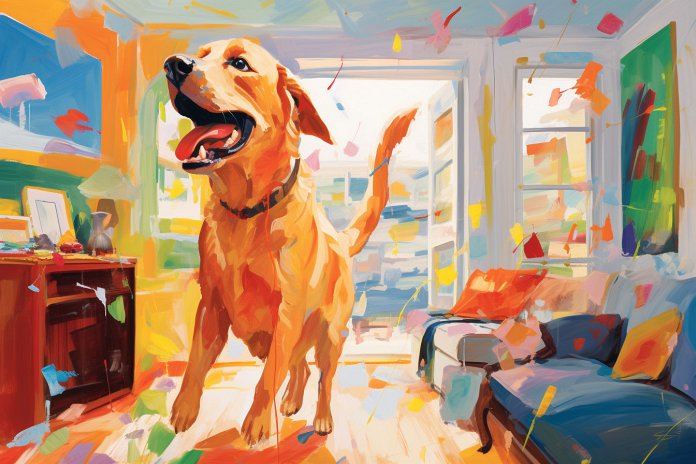
Painting with dogs in the house< can be dangerous, as dogs are very smell-driven and paint can be toxic for them. Even the fumes from paint can cause damage to dogs. So, how can you keep your pet safe from paint and ensure a safe paint situation? Read on to find out!
Signs Your Dog is Getting Sick from Paint Smell or Ingestion
Dogs can definitely smell paint and will want to investigate it. However, paint can be harmful to dogs, especially the fumes and accidental ingestion. Look for signs such as vomiting, diarrhea, incoordination, system depression, lethargy, difficulty breathing, and tremors.
Body Language
Signs that your dog might be affected by paint fumes or ingestion include shaking, cowering, panting, weakness, tail tucking, dilated pupils, whale eye, sleepiness, and other signs such as vomiting, drunk walking, confusion, and diarrhea.
The History of Paint
Paint used to be much more dangerous than it is now, with lead-based pigments causing serious harm. The use of lead in consumer paint was banned in 1978. However, paint still contains volatile organic compounds (VOCs), which can be dangerous to inhale and ingest.
The Science of Paint Being Bad for Dogs
Most paints are toxic for dogs due to the harsh, poisonous chemicals they contain. VOCs are released into the air during painting and are known carcinogens linked to cancer. These VOCs also contain other harmful chemicals.
Training Your Dog to Leave Paint Be
Training your dog to listen to basic obedience commands is important, but there are additional factors to consider. Never leave paint trays or open cans of paint accessible to your dog. Keep your dog outside or in a well-ventilated room during the painting process. Ensure your dog is comfortable in their crate or a special room to prevent destructive behaviors. Open windows and doors while painting to keep harmful fumes away from your dog.
“Protect your furry friend: Keep them safe from paint and its toxic allure.”

Tips & Things to Know
1️⃣ Keep your dog away from paint and paint fumes: Dogs are attracted to the smell of paint and may try to lick or ingest it, which can be toxic for them. Make sure to keep your dog in a different, well-ventilated room or outside while painting to prevent them from getting exposed to the fumes or accessing the paint cans.
2️⃣ Look out for signs of paint poisoning: If your dog shows symptoms such as vomiting, diarrhea, incoordination, weakness, difficulty breathing, or tremors, it may be a sign that they are being affected by the paint. Pay attention to your dog’s body language, including shaking, cowering, panting, dilated pupils, and other signs of distress.
3️⃣ Train your dog to avoid paint: Teach your dog basic obedience commands like “no,” “stay,” and “leave it” to prevent them from getting too close to the paint. Never leave paint trays or open cans of paint within your dog’s reach. Also, ensure that your dog has a comfortable and secure space, such as a crate or a designated room, to stay in while you are painting to avoid any destructive behaviors.
Frequently Asked Questions, Answered ✅
1. How can you keep your dog safe from paint fumes and ingestion?
– You can keep your dog safe by not leaving paint trays or open cans of paint laying around, ensuring your dog is in a different, ventilated room during the painting process, and training them to stay away from the paint.
2. What are the signs that your dog is getting sick from paint smell or ingestion?
– Signs that your dog may be affected by paint fumes or ingestion include vomiting, diarrhea, incoordination, system depression, lethargy, weakness, difficulty breathing, and tremors.
3. What are the body language signs that your dog might be affected by paint fumes or ingestion?
– Body language signs that your dog might be affected by paint fumes or ingestion include shaking, cowering, panting, weakness, tail tucking, dilated pupils, whale eye, and sleepiness.
4. What is the history of paint and its dangers?
– Paint used to be more dangerous as it contained lead, which was banned in consumer paint in 1978 due to its harmful effects. However, paint still contains volatile organic compounds (VOCs) that can be dangerous to inhale and accidentally ingest.
5. Why is paint bad for dogs?
– Most types of paints are toxic for dogs as they contain harsh, poisonous chemicals that can cause irritation and other health issues. Paint also releases VOCs, which are known carcinogens and can be linked to cancer.